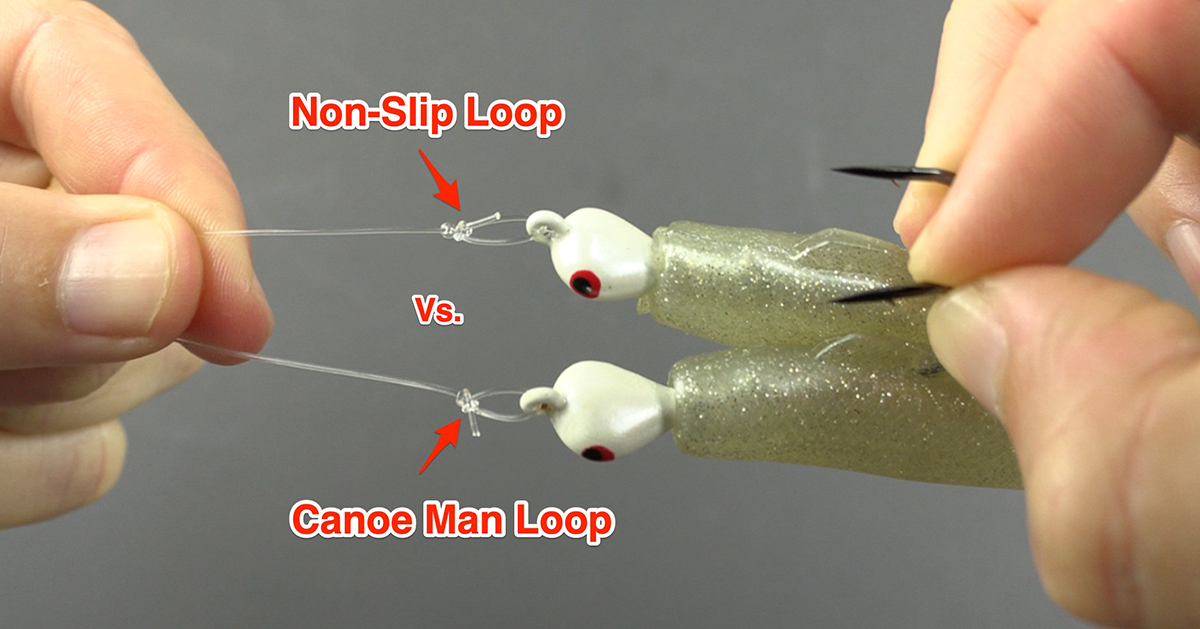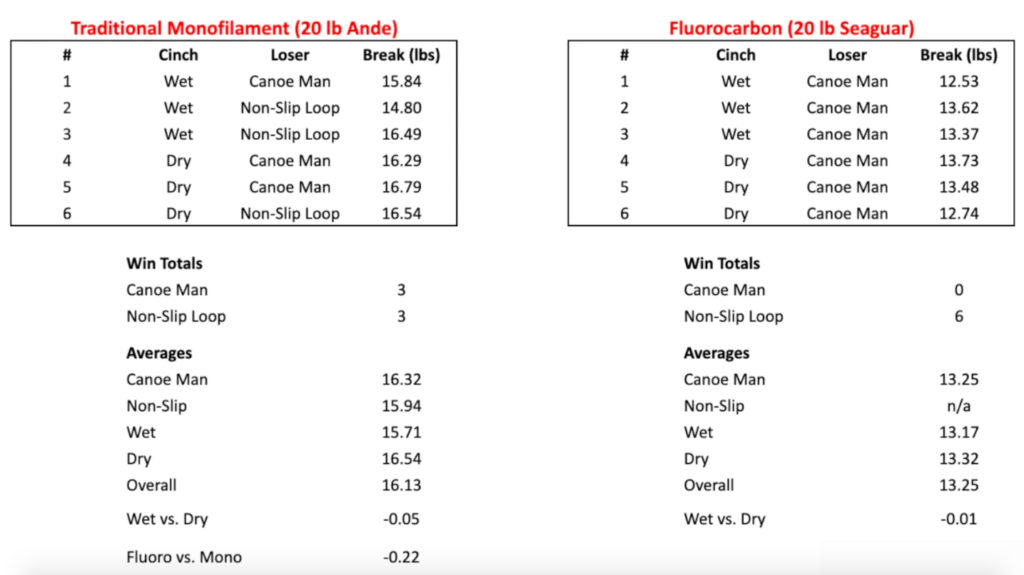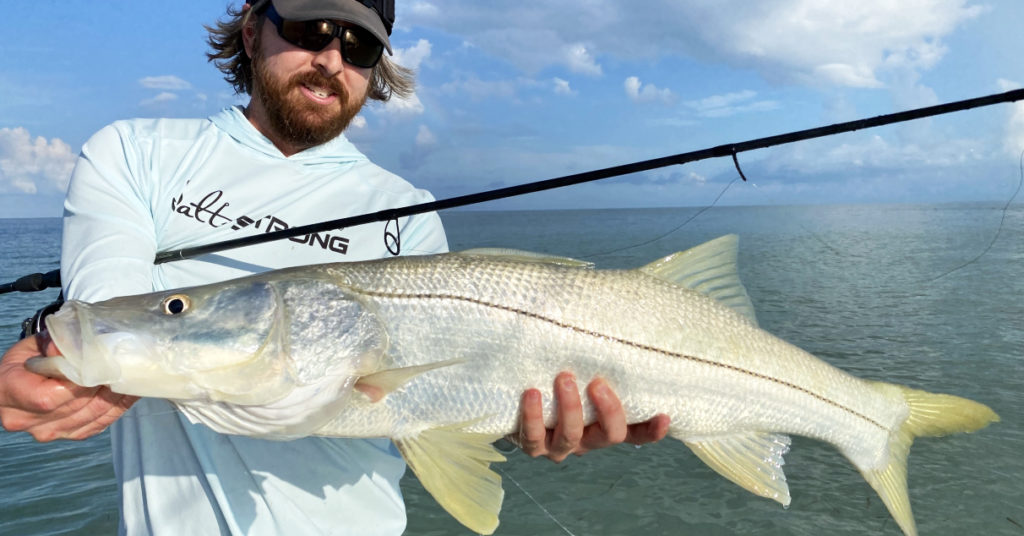Non Slip Loop Knot vs. Canoe Man Loop Knot: Surprising Contest Results
- By: Luke Simonds
- on

Do you use a loop knot when rigging your artificial lures?
Then you’ve got to see these shocking non slip loop knot vs. canoe man loop knot results.
Normally, when I test two knots or types of line against each other, they’re pretty comparable.
But one aspect of this test was a real eye-opener (especially for those people who use fluorocarbon and the canoe man loop knot).
See the surprising results of this experiment in the video below.
Non Slip Loop Knot vs. Canoe Man Loop Knot [VIDEO]

Gear used:
- 20 lb. Ande Monofilament
- 20 lb. Seaguar Blue Label Fluorocarbon
- Mission Fishin Jig Head
- Z-Man Slam Shady
Here are the full results of the experiment:

How the canoe man performed with fluorocarbon vs. monofilament is one of the biggest differences in performance I’ve seen in a knot contest.
The canoe man loop knot was about 20% stronger when tied with monofilament than it was when tied with fluorocarbon.
And to make sure it wasn’t just a fluke with one brand, I used three different types of fluorocarbon.
So if you like to tie the canoe man loop knot, I definitely recommend going with monofilament.
But if you’re stuck on fluorocarbon, then I definitely recommend using a non slip loop knot.
Here are some other notable results:
Canoe Man Loop Knot vs. Non Slip Loop Knot (Tied With Monofilament)
These two knots were roughly the same strength when tied with monofilament (the canoe man was slightly stronger).
Using Saliva With Monofilament
Knots that were tied with monofilament where I did not use saliva were 5% stronger than knots where I did use saliva when cinching it down.
When using fluorocarbon there was just a 1% difference in strength, so as it turns out, you probably shouldn’t use saliva when cinching down your knots.
Cost of Monofilament vs. Fluorocarbon
Here are the costs per yard of the lines I tested:
Ande Monofilament (20 lbs): $0.10/yard
Seaguar Blue Label Fluorocarbon (20 lbs.): $0.40/yard
Seaguar Premier Fluorocarbon (20 lbs.): $0.46/yard
Yo-Zuri Fluorocarbon (20 lbs.): $0.43/yard
So even though fluorocarbon is 4x more expensive per yard, monofilament is actually stronger.
Plus, monofilament is more abrasion resistant, too.
Conclusion

I love finding surprises in my experiments like the canoe man loop knot – fluorocarbon relationship here.
It just goes to show that experiments like this are necessary if we want to be sure were armed with the best knots and gear when going fishing.
You can get Ande monofilament from our shop here.
Did this experiment surprise you?
Which of these knots do you prefer?
Which of these lines do you use?
Let me know down in the comments!
And if you have any questions or suggestions about this experiment, leave those down in the comments too!
P.S. Want access to our best fishing spots and tips, plus discounts to our online tackle store? Click here to join us in the Insider Club!
Related articles:
Related categories:
STOP WASTING TIME ON THE WATER!
Do what the “SMART ANGLERS” are doing and join the Insider Club.
Here’s what you’ll receive today when you join:
- Weekly fishing reports and TRENDS revealing exactly where you should fish every trip
- Weekly “spot dissection” videos that walk you through all the best spots in your area
- Exclusive fishing tips from the PROS you can’t find anywhere else
- Everything you need to start catching fish more consistently (regardless if you fish out of a boat, kayak, or land).










What knot are you using to tie the leader to the swivel ?
Hey Luke I am wondering if you have tested the “mirro lure loop knot”. I have used this for ever without failure and just recently found the name. Wondering how it stacks up?
I’m actually not familiar with that knot. Can you please send a link to a video on how to tie it?
Luke I do a three step cinch on the canoe man knot. I wonder what kind of different results that would produce if any difference
It is certainly possible that a methodical cinch of a knot can help it have a stronger hold.
I am not sure how to do that. You can find it under mirrolure loop knot. You make the loop, put tag end through eye of lure, up and through the loop, take the tag around main line (one time) and back through the loop you just made. It is like your knot but you do not go back through the first loop as you do. I hope this helps as it is the second time I have tried to get this to you. Thanks Luke
Sounds like it’s just the Non-Slip Loop knot with 1 turn around the mainline. Here’s a test I did on that knot (I tested 2 turns, 3 turns, and 4 turns… since 3 was stronger than 2, it’s a very safe bet that 2 is stronger than 1). https://www.saltstrong.com/articles/twists-for-non-slip-loop-knot/
Please check 3-turn Surgeons Loop knots with your awesome test rig. I have been using a Surgeons Loop Knot with three turns for tying jigs as shown by Richard Gene on YouTube, https://www.youtube.com/watch?v=cXqIPXWbk-4 Based on my rudimentary breaking tests with knots on each end of 20-Lb mono, the Surgeons Loop seems a little stronger than the Non-slip Loop. I ran some tests with the same type knot on each end of the line. The break strength indicated by the 50-Lb scale that I used varied with how fast I applied the force, but the Surgeons loop seemed to be stronger by a pound or two. The break point with two Surgeons Loops was always between the knots. With two Non-slip Loops, each break point was next to a knot on the outside. I ran more tests with a Surgeons Loop on one end of the mono and a Non-Slip Loop on the other. The Non-Slip Loop knot broke first each time, and the break points were always next to the knot on the outside. All knots for the tests were tied and tested dry.
Was the Fluor leader or regular line? I am still not convinced that mono is really so much more visible in the water. Mono caught a lot of fish before Fluor.
The fluoro used in this test was leader line (seaguar blue label).
Please address line twist. It is my all-time frustration.
Here’s a link to see tips related to line twists: https://www.saltstrong.com/?s=line+twist
Mark sosin used a hufnagel loop knot. I wonder how that knit compares to the loop knot you use. I’ve been using the hufnagel loop knot for over 20 years. But, I’ve never given a thought to how strong it is in comparison to other loop knots. Maybe you could test it sometime? Thanks for the info
I have tested a knot similar to that called the Figure 8 in which it starts with a double overhand before threading on the lure. Then the tag end gets threaded through the way it came before doing a coil around the main line and threading it back through the double overhand’s two loops. It tested out worse than the more basic Non-Slip Loop knot so I have to assume that the hufnagel will test that way too.
Given that the double overhand start requires more time/concentration to tie since the tag has to get threaded through two small openings plus the fact that the hufnagel leaves the tag end pointed back to the rod, I’m siding with the non-slip loop knot given that it’s easier to tie and leaves the tag end pointed towards the lure to that it can’t snag onto weeds.
BTW Luke. You should do a comparison between the visibility of line tied dry vs line tied wet. Just a thought.
I mango fish a lot. They are some of Gods most cautious fish in the water. Still rather use Fluor and definitely will still wet the line before I tighten the knot because I feel if not you cause abrasion to the line when it is tightened, therefore making it more visible to the fish. I tell my kids in fishing school all the time, the fish ain’t looking at your fancy rod snd reel. He is looking at your terminal tackle, and that can make or break you.😄 Thanks for all y’all do Luke. Bama Dave
Very telling comparisons. Just blow up all my understanding.